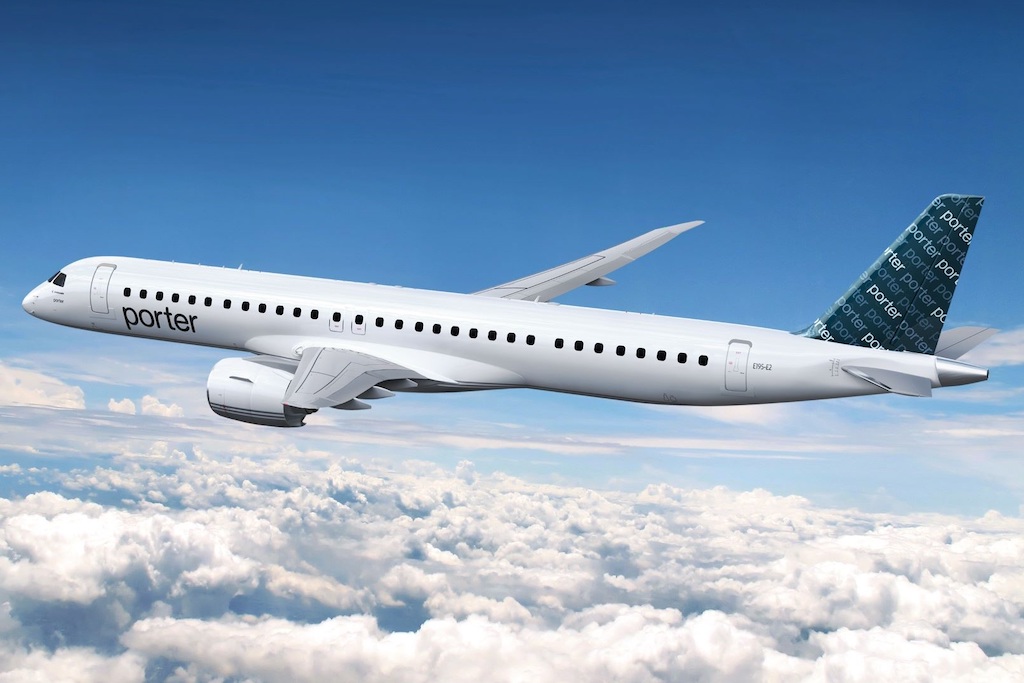Porter Goes From Turboprops to Jets With Plans to Become a Canadian National Airline

Photo Credit: Porter Airlines has ordered up to 80 E195-E2s. Porter Airlines
As many warned that niche Canadian carrier Porter Airlines may have flown its last flight, the airline had something else up its sleeve. On Monday, Porter unveiled an order for up to 80 Embraer E195-E2s and big ambitions for new nonstops across North America from eastern Canada's largest cities — setting up what could be a fierce competitive battle for Canadian travelers.
The order is split between 30 firm E195-E2s with the first due in mid-2022, plus purchase rights for another 50 aircraft. The jets will fuel growth to destinations in western Canada, as well as the Caribbean, Mexico and what the airline termed "sunny spots" in the U.S., from Halifax, Montreal, Ottawa and Toronto Pearson. The latter Pearson service will complement Porter's long-standing base at Toronto Billy Bishop Airport, where flights resume on September 8.
The move also marks the likely realization of Porter's long-standing dream to fly jets. In 2013, the airline committed to up to 30 Bombardier CS100s — now the Airbus A220 — and unveiled ambitious plans to extend Billy Bishop's nearly 4,000-ft. runway and modify the so-called tripartite agreement to accommodate the aircraft at the airport. That plan — and the aircraft order — died in 2015 when the Canadian federal government declined to review the tripartite agreement that barred jets at Billy Bishop.
"We believe that now is the right time to make this investment as the pandemic resets the aviation landscape," Porter CEO Michael Deluce said in a statement. "Adding a diverse selection of popular business and leisure destinations to our network means that we are better positioned to serve the needs of many more passengers."
That pandemic reset is occurring throughout the airline industry. Transat, which long focused on building a vertically integrated travel company, is ditching its hotel business in favor of building a leisure-focused hub-and-spoke network at its Montreal and Quebec City bases. Elsewhere, JetBlue Airways used the crisis to open bases at previously constrained hub airports Los Angeles and Newark; and the industry is seeing a raft of new startups, including Connect Airways that aims to challenge Porter at Billy Bishop and new Icelandic ultra low-cost carrier Play Airlines, a Wow Air reboot.
By Porter's measure, the reset has resulted in permanent capacity cuts in Canada, as well as financial harm to some of the country's largest carriers, Deluce told Airline Weekly in an interview. While he did not name names, Air Canada retired 79 aircraft and cancelled orders for both A220s and 737 Maxes as a result of the crisis. Deluce added that the pandemic also opened up aircraft delivery slots, and created opportunities to hire crews and expand into previously restricted airports.
“Out of crisis often comes opportunity," he said.
Porter's expansion will essentially create four network carriers in Canada, a country of nearly 38 million people that has long struggled to support two major airlines. The country's largest airline, Air Canada, dominates all four cities identified by Porter for its new E2 bases and is rapidly resuming flights as the country's external and internal travel restrictions ease. WestJet is a large competitor in Toronto and had ambitious growth plans when it was acquired by private equity firm Onex in 2019. And, as mentioned, Transat plans to pivot to a network model leveraging its strong brand presence in Quebec.
Asked about that competition, Deluce said that Porter only views Air Canada and WestJet — not Transat — as competition. He added that the airline has done "very well" competing with the country's two largest carriers in eastern Canada since its founding.

Citing the small size of the E2 and its range of nearly 3,000 miles, Porter's plans for the jets include opening new nonstop routes currently only served via connections by other airlines. The E195-E2 seats 132 passengers in a standard all-economy layout, according to Embraer — significantly fewer than the 169 and 174 seats, respectively, on Air Canada and WestJet's Boeing 737-8s. However, Air Canada is also pursuing the open-new-nonstops strategy with its growing fleet of A220-300s that seat 137 passengers.
Porter selected the E195-E2 over the A220 for its lower trip costs, said Deluce. He added that the jet, which uses the same Pratt & Whitney geared turbofan engines as its competitor, is "more environmentally friendly" in terms of both sound footprint and carbon.
The airline also has substitution rights for the smaller E190-E2. The latter aircraft seats 106 passengers in a standard all-economy configuration.
The Porter order is also something of a coup for Embraer. The E2 has lost ground in the small mainline narrowbody segment to the A220, which Airbus acquired from Bombardier in July 2018. The Brazilian planemaker's last major order for the type was for up to 35 aircraft from KLM in 2019 though the pandemic brought nearly all aircraft orders to a full stop. And Porter is Embraer's first firm customer for the E2 in North America after losing campaigns to replace older E190s at both Air Canada and JetBlue to the A220.
Embraer first disclosed the E195-E2 order as for an undisclosed customer in its first quarter results in April.
UPDATED: With comments from Porter CEO Michael Deluce.
